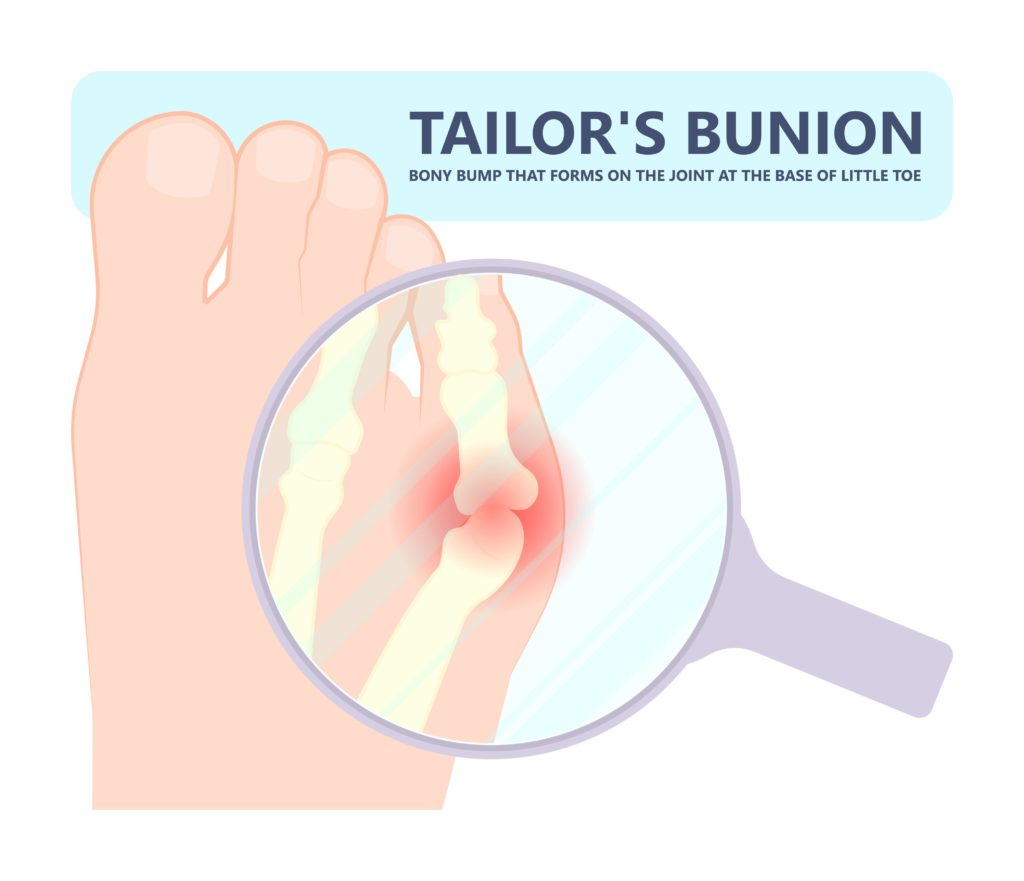Bunionette Surgery in Boise
What is a bunionette?
A bunionette is a bump that forms on the side of the foot near where the pinky toe attaches to the foot. Bunionettes are also known as a tailor’s bunion and can be both painful and even develop a callus over it. This bump can rub against footwear, leading to discomfort. If left untreated, the bunionette can change the shape of the foot, making it hard to find shoes that fit properly or even develop a wound over the deformity. Therefore, it is important to seek treatment for a bunionette to prevent the condition from worsening.

How Does a Bunionette form?
While the exact cause of bunionettes is not fully understood, certain factors are commonly associated with the condition. These include arthritis (such as rheumatoid arthritis, psoriatic arthritis, and gout), neuromuscular conditions like cerebral palsy, and connective tissue disorders like Marfan’s syndrome. Tight-fitting shoes, especially those with high heels or narrow toe boxes, and genetics can also contribute to the development of bunionettes.
What are the Symptoms of a Bunionette?
The most common symptom of a bunionette is pain on the outer side of the foot near the pinky toe. The bony bump at the base of the toe can become pronounced, making it difficult to find comfortable shoes. Additionally, the pinky toe may start to turn inward, affecting the way you walk and causing further discomfort. Other symptoms may include redness, swelling, and the formation of calluses at the site of the bunionette.
Diagnosing a Bunionette
Bunionettes are typically diagnosed by a physician or orthopedic surgeon. To make a diagnosis, the doctor will review your medical history, examine your foot for any misalignment or soft tissue damage, and may order imaging tests such as weight-bearing x-rays to assess the severity of the bunionette and any deformity in the toe joints.
Treatment Options
In order to alleviate pain associated with bunionettes, many doctors will first explore conservative treatment options. These may include the use of orthotics to realign the bones and reduce pain, as well as padding the affected area to minimize rubbing and irritation. Special footwear that eliminates rubbing and pinching may also be recommended, and pain medication and icing may be used to improve overall patient comfort. While these conservative measures can help improve comfort levels, they do not correct the underlying condition and cannot prevent it from getting worse.
When conservative treatment options are unable to relieve pain caused by the bunionette, surgery is often necessary to repair the condition.
Surgical treatment for a Bunionette
There are several surgical options available for the treatment of bunionettes, and the specific approach used will depend on the shape of your pinky toe and the 5th metatarsal. For instance, correction of the bunionette with a fifth metatarsal oblique osteotomy surgery involves surgically cutting and realigning the bone at the base of the pinky toe joint and in more mild cases it may involve simply shaving the bone at the deformity. Your surgeon will choose the most appropriate surgical option based on your individual needs.
Risks and Complications
Like any surgical procedure, bunionette surgery carries certain risks and potential complications. These can include skin healing issues, bone healing issues, infection, numbness, unresolved pain and swelling, recurrence of the bunionette, and stiffness.
Postoperative Care
It’s important to follow your surgeon’s instructions carefully during the postoperative period. After bunionette surgery, you’ll need to wear a special postoperative shoe to protect your wounds and help you walk. It’s also essential to keep your foot elevated as much as possible to reduce swelling. The dressings should be kept dry and left alone until your follow-up appointment. You won’t be able to wear regular shoes until six weeks after your surgery.
Flint Foot and Ankle is trained in providing bunionette treatment, including surgical intervention. Our board certified orthopedic surgeon and foot specialist is highly trained in addressing bunionette-related issues and understands the pain and discomfort associated with this condition. In addition to surgical treatments, Flint Foot and Ankle offers a comprehensive range of non-surgical bunionette treatment options, including orthotic devices, padding, and special footwear designed to alleviate pain and minimize pressure on the affected area.
If you are struggling with bunionette pain and discomfort, we encourage you to contact us to schedule a consultation with one of our experienced specialists. We look forward to helping you regain your mobility and live your best life.

